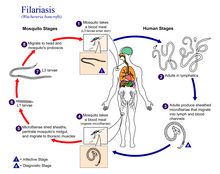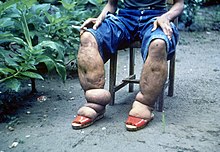Elephantiasis
Elephantiasis or elephantiasis ( Greek ελεφαντίασις , roughly "the elephant-like character", from ὁ ἐλέφας , "the elephant"; also elephant man syndrome ) is an abnormal enlargement of a body part due to lymphatic congestion ( lymphedema ). Usually the legs or the external genitals are affected. This disease is particularly common in developing countries. A distinction is made between acquired and innate forms.
| Classification according to ICD-10 | |
|---|---|
| B74.- | Filariasis (helmet pants) |
| B74.0 | Filariasis due to Wuchereria bancrofti (Including: elephantiasis due to Wuchereria bancrofti and lymphatic filariasis) |
| B74.9 | Filariasis, unspecified |
| ICD-10 online (WHO version 2019) | |
Acquired forms

Consequence of infectious diseases

The disease occurs as elephantiasis tropica mainly in tropical regions and is triggered here as a late consequence of various infections, among others by roundworms such as Brugia malayi (also called Wuchereria malayi or Filaria malayi ) or Wuchereria bancrofti , but also by leprosy . The worms get into the lymphatic system through the bite of a mosquito and cause a chronic inflammatory reaction with lymph congestion, which over time leads to extreme enlargement and hardening of the skin. As a prophylaxis , protection from mosquitoes with repellants or mosquito nets is recommended.
Elephantiasis can also be a complication of erysipelas, which occurs worldwide, due to the inflammatory destruction of the lymphatic drainage pathways . In addition, after repeated severe cases of cold sores, so-called macrocheilia (Greek μακροχειλία , macrochilía , "big lips") can occur.
Other causes
The disease can result from severe superficial phlebitis with massive tissue congestion.
Tumor diseases can also lead to elephantiasis, either directly through the closure of lymph vessels by tumorous lymph metastases or indirectly as a side effect or necessary removal of metastases as part of the therapy: with surgical removal of the lymphatic tracts, e.g. B. as persistent arm swelling after breast cancer surgery, or with radiation therapy.
Especially with cancer and cancer therapy with elephantiasis development, late cases of secondary malignant tumors have occurred, which can be considered a complication of elephantiasis: These are mostly fast-growing sarcomas , which are summarized under the term 'Stewart-Treves syndrome'. The only curative treatment option is the most radical possible amputation of the affected limb; However, when the diagnosis is made, there are usually metastases that only allow palliative (relieving) chemotherapy with cytostatics or palliative medical care.
Another non- infectious type is podoconiosis , in which microparticles of volcanic origin get into the subcutaneous tissue when walking barefoot, where, as a result of infections, the lymphatic pathways are indirectly blocked.
Congenital forms
As elephantiasis congenita hereditary (Latin congenitus , "innate" and hereditarius "inherited") is called a to those in infants developing swelling body parts that have erblicherseits or insufficient by a developmental disorder or no Lymphabflussbahnen.
Another congenital form exists in the context of complex malformation syndromes such as neurofibromatosis .
treatment
The disease is not communicable. There is no real cure. Although the causes of the lymph congestion are irreversible in many cases, the external symptoms are reversible and easily manageable for many patients through the consistent use of manual lymph drainage several times a week and the permanent wearing of compression bandages or stockings. If the skin has been overstretched, its original elasticity is hardly restored. A tightening of the skin and subcutaneous tissue can then be considered as part of plastic surgery , which, however, cannot completely reconstruct the original skin properties. However, attempts to extensively peel off all of the jammed tissue have proven useless in the past and harmful because of the extensive scarring.
Individual evidence
- ↑ Chintamani, J. Singh et al. a .: Vulval elephantiasis as a result of tubercular lymphadenitis: two case reports and a review of the literature. In: Journal of medical case reports. Volume 4, Number 1, November 2010, p. 369, ISSN 1752-1947 . doi : 10.1186 / 1752-1947-4-369 . PMID 21092075 . PMC 2994881 (free full text).
- ↑ a b c d e f g Pschyrembel Clinical Dictionary Version 2002 (electronic version of the 258th edition)
- ^ Roche Lexicon Medicine, 5th edition (online version)
